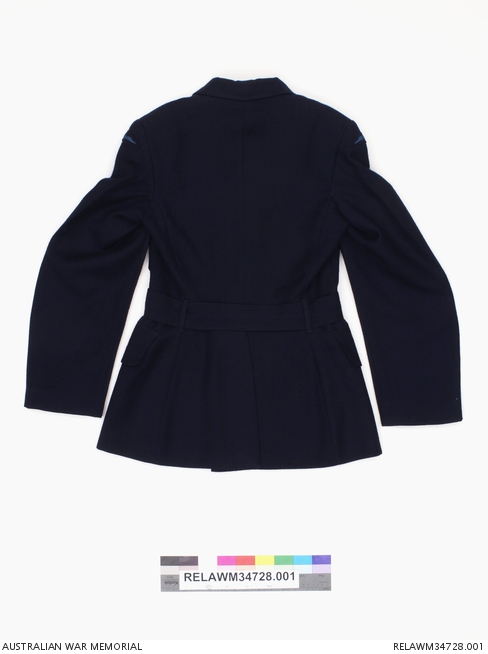| Place | Europe: United Kingdom, England, Suffolk, Mildenhall |
|---|---|
| Accession Number | RELAWM34728.001 |
| Collection type | Heraldry |
| Object type | Uniform |
| Physical description | Cotton, Plastic, Wool |
| Maker |
Joseph & Myers |
| Date made | 1941 |
| Conflict |
Second World War, 1939-1945 |
RAAF winter service dress tunic : Flight Sergeant R H Middleton, 149 Squadron RAF




RAAF blue wool serge OR's winter service dress tunic with a pair of pleated breast patch pockets and a pair of internal waist pockets. The pockets have flaps, those on the breast being secured by black plastic buttons. A pair of blue and white embroidered RAAF pilot's wings are placed above the left hand breast pocket, with the rank insignia of Flight Sergeant (a crown above three stripes) on each sleeve. On each shoulder are embroidered Air Force eagle patches. The tunic is closed by four large black plastic buttons, and belted at the waist. The self fabric belt has a black plastic buckle with two metal claws. There are two loops on the back waist to retain the belt on the tunic. A white cotton label inside the collar reads 'JOSEPH & MYERS 1941 SIZE' followed by a a box containing the numerals '347 8' in ink.
Rawdon Hume Middleton (Rawdon to his family and friends in Australia, but generally known as 'Ron' in the Air Force) was born at Waverley, NSW, in July 1916, but moved with his family to the Parkes district while still a child. A keen sportsman, he was working as a jackeroo when the Second World War broke out. In October 1940 he enlisted in the RAAF, and as an Empire Air Training Scheme cadet pilot, was trained in Australia, Canada and the United Kingdom. In early 1942 he was posted as a Sergeant pilot to an operational unit, 149 Squadron RAF, flying Short Stirling bombers out of Mildenhall and nearby Lakenheath in Suffolk. For some months he gained experience flying operationally as a second pilot, but by the end of July was captain of his own crew, which he led on a number of missions over Germany and Italy. On the night of 28-29 November 1942, he and his crew set out to raid the Fiat works in Turin, Italy. Their heavily laden aircraft was barely able to make the climb over the Alps, and was then damaged by flak over the target, Middleton, his second pilot and the wireless operator all being wounded by a shell which burst in the cockpit. Despite terrible wounds to his head, Middleton determined to make the return flight to England, in order that his crew should have the best chance of survival. Upon finally reaching the English coast, having been further damaged by flak in crossing the French coast, and with only five minutes' fuel remaining, he ordered the crew to bail out, the front gunner and flight engineer remaining in the aircraft to assist their captain. The Stirling then crashed into the sea, and all three were killed. Middleton's body was not recovered from the ocean until February 1943, and he was buried at Beck Row, Suffolk, not far from his old base. Although the citation for the Victoria Cross and the uniform tunic show the rank of Flight Sergeant, Middleton had been expecting a commission which was eventually granted, back-dated to 15 November 1942.
Related information
Conflicts
Subjects
People
Related Objects
- Victoria Cross : Flight Sergeant R H Middleton RAAF, 149 Squadron, RAF
- Pilot Officer Rawdon Middleton
- 1939-45 Star : Flight Sergeant R H Middleton RAAF, 149 Squadron RAF
- Air Crew Europe Star : Flight Sergeant R H Middleton RAAF, 149 Squadron RAF
- Defence Medal : Flight Sergeant R H Middleton RAAF, 149 Squadron RAF
- British War Medal 1939-45 : Flight Sergeant R H Middleton RAAF, 149 Squadron RAF
- Australia Service Medal : Flight Sergeant R H Middleton RAAF, 149 Squadron RAF